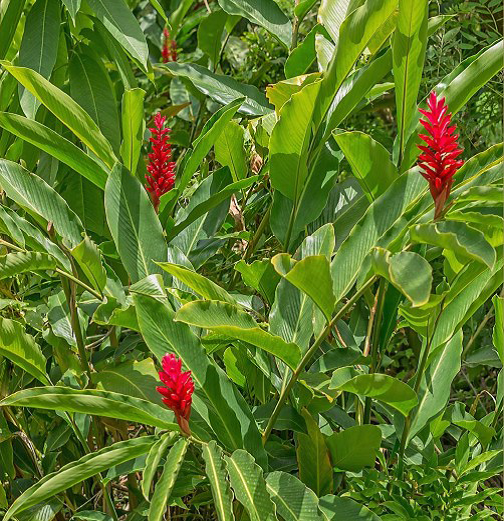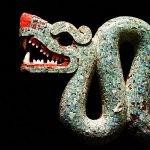By Kirby Vickery from the April 2017 Edition
Happy spring time everyone. It is the time for nature’s rebirth and the lands are full of life, music, color (or 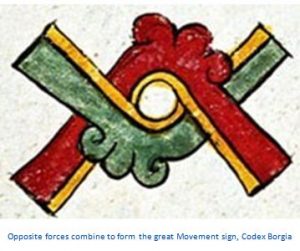 colour depending), dance and happiness. One of the more flamboyant styles of celebration comes from the Mexican people. They say it’s the ‘Latin’ influence in the culture. I say it goes further back than that. The ‘oomph’, ‘oomph’, of the Mexican country western music is tied in with the Germanic folk genre but the flash of the rest of it probably runs into the world of the ancient Olmecs. This fable exemplifies the duality the Aztec gods had. They were all both good and evil and male and female at the same time. This cute little story exemplifies this dualism in more than one way and there are several versions of it out there.
colour depending), dance and happiness. One of the more flamboyant styles of celebration comes from the Mexican people. They say it’s the ‘Latin’ influence in the culture. I say it goes further back than that. The ‘oomph’, ‘oomph’, of the Mexican country western music is tied in with the Germanic folk genre but the flash of the rest of it probably runs into the world of the ancient Olmecs. This fable exemplifies the duality the Aztec gods had. They were all both good and evil and male and female at the same time. This cute little story exemplifies this dualism in more than one way and there are several versions of it out there.
Although enemies from time to time, the Sky God, Tezcatlipoca, was out for a walk on a sunny beach one day with the god of wind, Quetzalcoatl. He asked Windy what he was up to and why he was late for their meeting and got the reply, “I am Quetzalcoatl, the mighty God of the Wind, and this is my hurricane season and I have to create great blows and waves which is a lot more important than walking around getting insulted by you about how I keep my calendar, or great minor God of the Dim.”
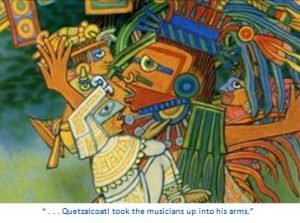 They proceeded to verbally jab at each other because, being gods, they had known each other for ever. Finally, Sunny waived at Windy and forced him to shut up. Then he said “Quetzalcoatl, tell me what do you hear.”
They proceeded to verbally jab at each other because, being gods, they had known each other for ever. Finally, Sunny waived at Windy and forced him to shut up. Then he said “Quetzalcoatl, tell me what do you hear.”
“Why nothing, of course, why do you ask?”
“That’s just it. There isn’t anything to hear. This world is quiet. There is no music, there is no laughter, the birds don’t sing and even the alligators aren’t croaking their romantic bellows to their ladies. There isn’t any sound on this world, and because of that there isn’t any joy or laughter either. Do you know where it all is?” He asked while looking right through Quetzalcoatl with daggers in his eye.
“No I don’t,” said Windy. “But I suppose you do, right?”
“Yes.” Tezcatlipoca replied. “Our brother, the Sun, has absconded with all the singers and musicians and has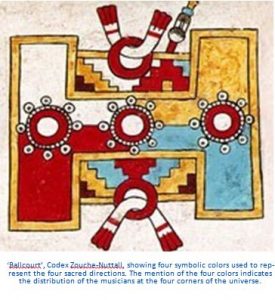 taken them all to his house. There he has them play and sing for him all the time. This leaves our world without. I need your help in getting them back so that we create a place that will thrive on happiness, joy and the sound of music.” He then smiled as the God of Wind agreed and flew out looking for the specific beach where the bridge to the House of the Sun existed.
taken them all to his house. There he has them play and sing for him all the time. This leaves our world without. I need your help in getting them back so that we create a place that will thrive on happiness, joy and the sound of music.” He then smiled as the God of Wind agreed and flew out looking for the specific beach where the bridge to the House of the Sun existed.
[At this point the story splits depending on which Codex you look through. The Codex ZoucheNuttall tells of Quetzalcoatl making this trip while another English author lists another minor god from an old French Codex. Another Codex, the Codex Borgia, states that Quetzalcoatl’s son makes this journey: “. . . his agent and creature Ehecatl, the wind god, cold like himself, black, shadowy, and armed with a bloody thorn.”]
Flying around, Quetzalcoatl found the right beach and ordered the minions of the Sun God to make a bridge to the House of the Sun. These were whale, the siren and the turtle, or the Cane and Conch, Water Woman, and Water Monster [again, depending]. The three servants reform and stretch out into the heavens to the House of the Sun and allow the God of the Wind a bridge to get there.
The Sun God orders his entertainment group to complete silence and to ignore Quetzalcoatl. He tells them that if they make one sound, the God of Wind will round them up and take them away to a dull and dim place without life or form.
Quetzalcoatl arrived and hears silence and responds with extreme anger. He rolls out the lightning and the thunder. He emits rocks. The place and the darkness with the rain cause these poor musicians to run for cover. They all run into the arms of Quetzalcoatl who raps them up in his loving arms and brings them to our world.
[Mythology in the Mesoamerican Tradition (University of Utah Press, 1996). López Agustín adds some fascinating commentary.Music, numbers, elements, order, spaces, times, colours – fundamental cosmic laws that appear, suggestively, throughout the width and breadth of the planet.
‘It is common in Mesoamerican traditions to find that the four colours associated with the quadrants of the earth’s surface were symbols of an order that governed the entire universe. In Mesoamerica, the four colours represented the correspondence between times and spaces, and they designated the places through which time flowed. At the ends of the world, four trees held up the skies, and the divine forces that came from on high and from below flowed inside their trunks. The colours might vary, and it is possible that besides the four colours at the ends of the world there was a fifth colour, that of the central tree, the axis of the universe. But in the codices, in songs, and in narrations the symbolism of colour was always important…’]
The flute players were dressed in golden yellow. The wandering minstrels wore blue. The lullaby singers were dressed in white, and the singers of love songs wore red.
The world could feel the impending arrival of Quetzalcoatl and his children as he felt for them now. The closer he got, the more colorful the world became. Flowers bloomed, fruit and maize ripened for the harvest. It was as if the world was waking up.
When they finally touched down, the musicians and singers started to play and sing. As if by magic, the world and animals all listened and began to sing themselves and beautiful music started to work its way around the world. To help things along, they began to tour the group around the world until the entire earth had been covered and was left with colors and wonderful sound and song.
Download the full edition or view it online
—
Kirby was born in a little burg just south of El Paso, Texas called Fabens. As he understand it, they we were passing through. His history reads like a road atlas. By the time he started school, he had lived in five places in two states. By the time he started high school, that list went to five states, four countries on three continents. Then he joined the Air Force after high school and one year of college and spent 23 years stationed in eleven or twelve places and traveled all over the place doing administrative, security, and electronic things. His final stay was being in charge of Air Force Recruiting in San Diego, Imperial, and Yuma counties. Upon retirement he went back to New England as a Quality Assurance Manager in electronics manufacturing before he was moved to Production Manager for the company’s Mexico operations. He moved to the Phoenix area and finally got his education and ended up teaching. He parted with the university and moved to Whidbey Island, Washington where he was introduced to Manzanillo, Mexico. It was there that he started to publish his monthly article for the Manzanillo Sun. He currently reside in Coupeville, WA, Edmonton, AB, and Manzanillo, Colima, Mexico, depending on whose having what medical problems and the time of year. His time is spent dieting, writing his second book, various articles and short stories, and sightseeing Canada, although that seems to be limited in the winter up there.



